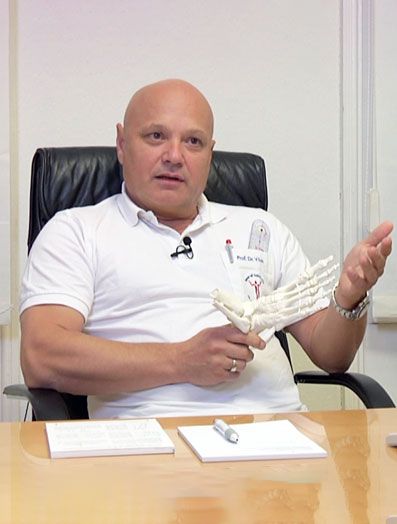Hallux and forefoot philosophy - minimaly invasive v-tek system
We offer:
Hallux valgus, splayfoot, tailor's bunion and hammer toes correction using an own innovative minimally invasive method since 2005
- No drill wires
- anatomical correction
- no bone removal or shortening in hammer toe surgery
- immediate full load even at maximum misalignment,
- repairs of operations that have not brought the desired result elsewhere.
- Incisions only 8 mm and 2 to 3 stab incisions.
The story behind it
Each of the 150 previously known worldwide operations of hallux valgus has at least one disadvantage (the large number is enough to suggest that no method is really faultless):
- Either the toe or the first metatarsal bone gets shorter or the correction is incomplete, or the joint angles are disturbed, therefore the deformity may recur sooner or later.
- Or the correction decreases and the first metatarsal goes up, resulting in overloading of the other metatarsals, possibly also leading to a fracture (march fracture)
- Or the wires emerge out of the toes, which represents a significant disability and an additional portal of entry for germs (infections).
- Or the structure is not sustainable and must be unloaded for weeks in the heel shoe or even put in plaster.
Mostly, however, the operations have more than one drawback - and a single method, though it is still common in many places, cannot be enough to correct all misalignments.
Hammer toes are still treated almost everywhere using the nearly 100 year old operation method by Hohmann (described in 1922), wherein the joint forming bone portion is removed, i.e. cut away. Actually a mutilating surgery, which, although it sometimes does deliver pretty good results, but which often leads to feeble stub toes and certainly favours the origin and development of hallux valgus (crooked big toe), because the other toes can no longer provide any support to the big toe.
The consequence of this
After much thought, and countless sketches and experiments since 2003, I have therefore developed new surgical methods, which lead to very good results and it seems that finally all the disadvantages are eliminated.
The new features
- Foot surgery without wires
- Implants inside the bone for a reliable, safe bunion and hammer toe correction, using the international famous V-tek System - minimally invasive. Mini scars.
- Full load immediately.
New since 2005: Correction with the intramedullary plate (lying inside the bone) - with a single system (but different implants), depending on the misalignment of the big toe requires:
- Small misalignments up to 14 degrees: Behind the head (subcapital) with the mini plate - 30 mm
- Moderate deformities up to 18 degrees:
At the base with the middle plate - 36 mm - Severe deformities over 19 degrees:
In the metatarsal joint (Lisfranc arthrodesis) with the long plate - 55 mm
This method shows previously unknown correction options, immediate load possible
Not all cases of hallux are treated with the same operation type, but the deformity is corrected on site and stabilized with a plate that is located INSIDE THE BONE.
The development of the V-Tek-Methode has been proven since 2005 internationally x-fold and is now mininal-invasive
- Foot surgery without drill wires - so no entry points for germs, no sacrificing of comfort, immediate movement of the joints for faster recovery, instead of cartilage loss and adhesions due to fixation by wires.
- Anatomic correction of hammer toe instead of bone removal - no wobbly stub toes, no loss of toe length, good kick in walking and running instead of the usual quasi amputation by the Hohmann technique.
- Reliable, safe Hallux correction - with the smallest cuts in case of slight variance.
- Anatomic correction of hallux without loss of length - even in case of massive or even bizarre deformities, no transfer of the ground forces to the small ball head with subsequent pain.
- Possible now thanks to new implants and operation methods - the operating technique depends on the degree of deviation. There are 3 different surgical techniques in hallux and 5 different techniques for the hammer toe - depending on the severity and stage. The implants are made of titanium and are (usually) not removed. Individual approach to the patient and to each foot, instead of "lumping it together" with a single surgical technique.
- Full load immediately possible for all operations - even at maximum corrections.
- Minimally invasive surgery for less pain, less swelling and a fast recovery.
Dr. Michael Vitek Prof. in. UAG
(Universidad Autonoma Guadalajara, Villahermosa, Tabasco, Mexico)



